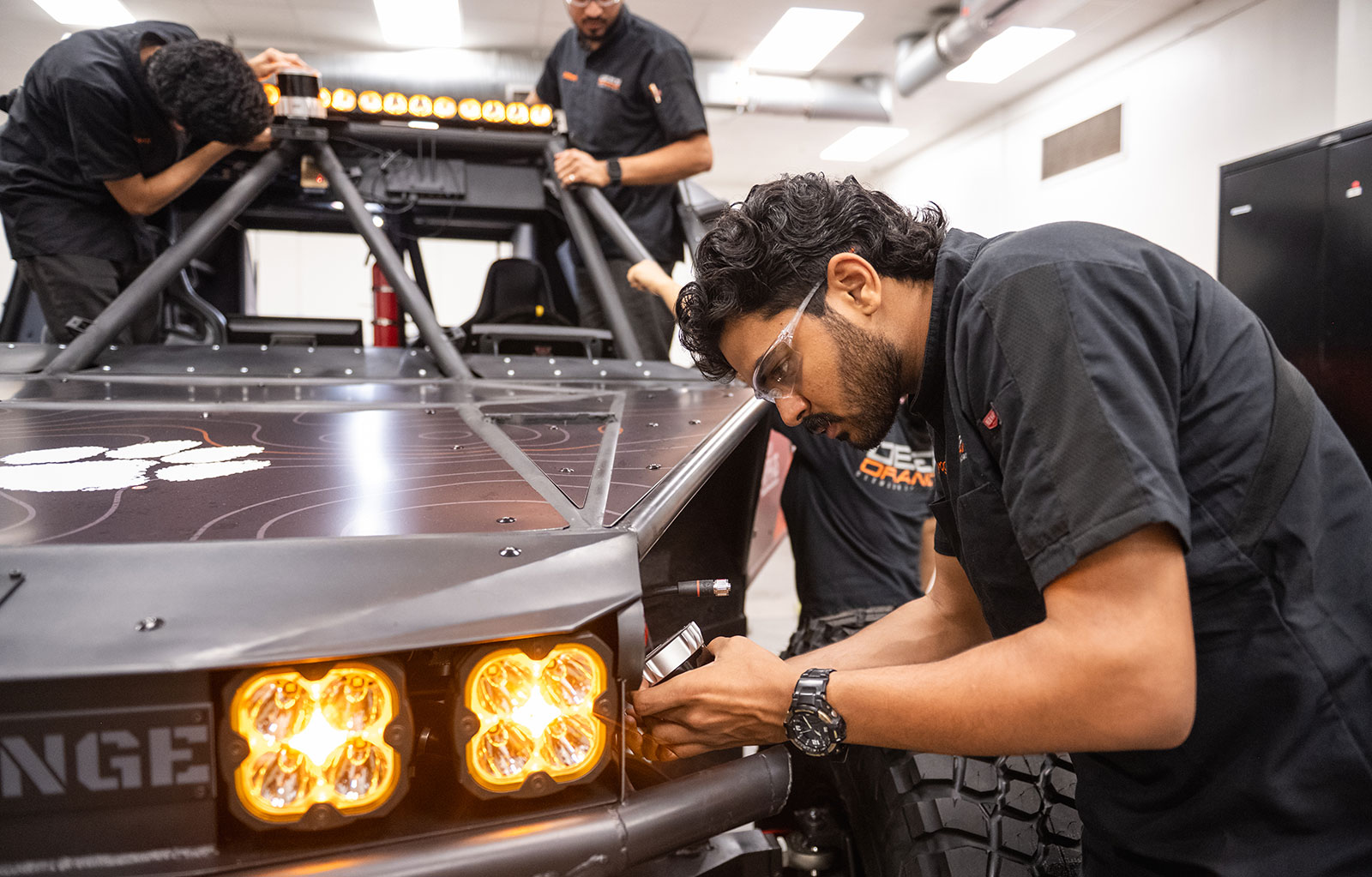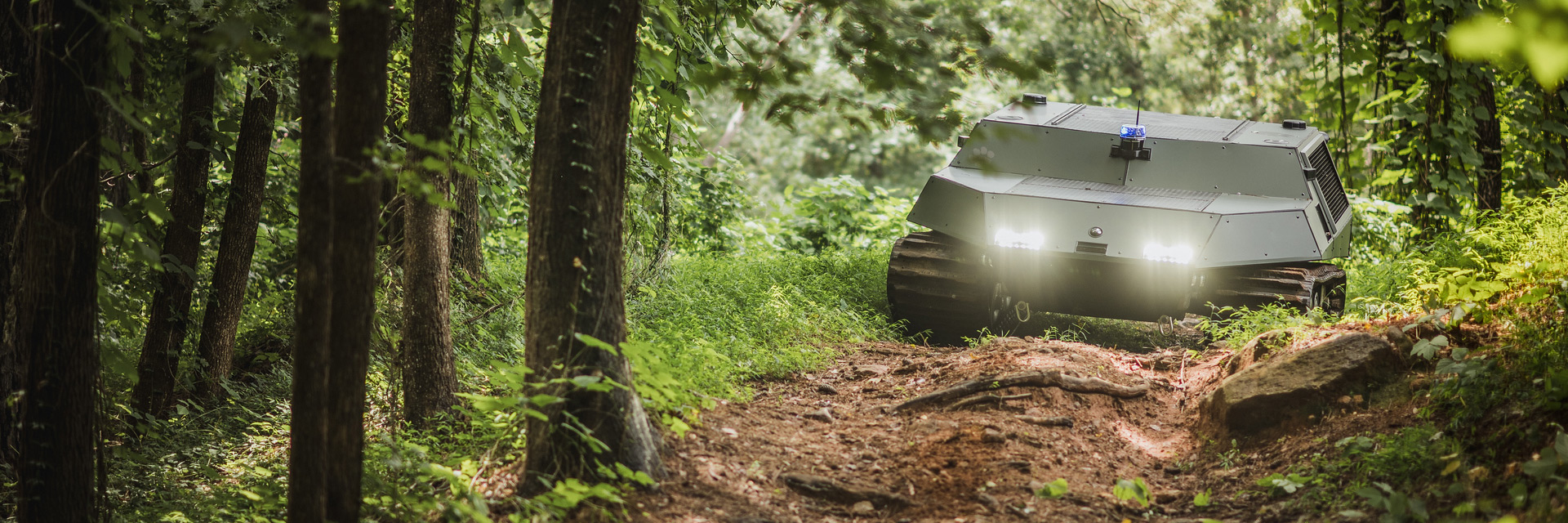Research Focus Area:
On-Road and Off-Road Autonomy

The On-Road and Off-Road Autonomy focus area emphasizes the integration of advanced sensing technologies, sensor fusion, and estimation systems to enhance situational awareness and inform machine learning-driven algorithm development. The research includes designing and deploying robust sensor architectures spanning vision, LiDAR, radar, inertial, and GPS systems and developing multi-modal data fusion techniques to improve perception, localization, and decision-making in uncertain unstructured environments.
Our goal is to enable novel approaches to multi-scale autonomous routing, coordination, and collaboration. Autonomous ground systems in this domain leverage enhanced scientific understanding and emerging technologies to augment multi-domain operations’ mobility and maneuverability components. Efforts also focus on engineering configurable, resilient, and fault-tolerant systems of automated vehicles capable of operating effectively in complex, unstructured environments.
To support rapid iteration and performance validation, this research explores the development and use of high-fidelity simulation environments and digital twin frameworks. These tools enable scalable testing, verification, validation, and refinement of autonomy algorithms under realistic and repeatable conditions, bridging the gap between laboratory development and real-world deployment.
Focus Area Director
Yunyi Jia
McQueen Quattlebaum Associate Professor, Department of Automotive Engineering
yunyij@clemson.edu
Research Efforts
-
1.1 Deep Reinforcement Learning Approach to CPS Vehicle Re-envisioning
Principal Investigator: Venkat Krovi
Motivation: Re-envision autonomy with Cyber-Physical System (CPS) off-road vehicle architecture concepts
Goal: Extract robust and reliable mobility & maneuver performance
Approach: AI-based frameworks to support both offline design-selection and online dynamic-orchestration of hierarchies of parameters, settings and behaviors
-
1.2 Enhanced Situational Intelligence for Off-Road Depot Vehicle through Collaborative Perception and Human-centered Algorithmic Intent
Principal Investigator: Sophie Wang
Motivation: Performing situational intelligence in terms of correlating, analyzing and visualizing disparate data, and providing intelligent decisions and actions out of a massive amount of data, is one of the major critical functions of armaments and military equipment
Goal: Provide situational awareness of both the mission environment and the human operator for effective automatic/manual decision-making inside a mobile depot vehicle
Approach
- Environmental situational intelligence: Sensor uncertainty characterization, sensor pose optimization, sensor fusion, semantic mapping, surrounding entities modeling and prediction
- Human situational intelligence: (Inverse) reinforcement learning, automated decision-aid, prototype of human-computer interface
-
1.3 Sizing, Routing, and Coordinating Multi-Scale Ground Vehicle Fleets
Principal Investigator: Pamela Murray-Tuite
Motivation: Develop techniques for smart management of forward-deployed fleets for mobility in unstructured environments
Goal: To determine the sizing, routing, and coordination of a heterogeneous team of AGVs in unstructured environments with AGV losses
Approach: Mathematical approaches and algorithms for adversarial reasoning, threat detection, team sizing, routing, distributed coordination, physics-based estimation and control
-
1.4 Cross-Cutting Autonomy-Enablers
Principal Investigator: Richard Brooks
Motivation
- Vehicle fleets are complex systems of systems
- Fleet needs: learning, security, connectivity, error detection, integration
- Framework: Correct failures, tolerate attacks, create resiliency
Goal
- End-to-end mission coordination
- System aspects needed for the distinctive GVSC mission
- Analyze performance, security, and adaptation
Approach
- Instrumented testbed in simulation and with vehicle platforms
- Accessible by VIPR GS researchers
- Evaluation of an autonomy architecture and the supporting functions.
- Agile, adaptive, responsive task authorization using Zero Trust overlay for ROS-like middleware.
- Adaptive UGV collision prediction and avoidance using Markov Chain with CARLA simulator and fault detection using Hidden Markov Models
- ROS 1 and ROS 2 network tests for drones and simulated vehicle fleets
- Developing the software-defined radio platform for dynamic spectrum access and customized communication interfaces.
-
1.5 Efficiency-Based Fleet Traversing Scheme Design Under the Risk of Disruptions Using Goal Programming Model
Principal Investigator: Judith Mwakalonge
Motivation: Supply chain disruption has become global due to the pandemic and the Russia-Ukraine war, which can result in severe economic and financial consequences. Route disruptions imply significant breakdowns in distribution nodes that comprise a supply chain. The design of an efficient and resilient fleet traversing scheme would be essential for the strategic plan of logistics systems.
Goal: Demonstrate how to design efficient fleet routing/traversing schemes under the risk of route disruption, given a set of transportation requests, a fleet of vehicles with capacities, and origin and destination nodes, while simultaneously considering the cost/time-efficiency of the system
Approach: Considering three objectives simultaneously, a goal programming (GP) approach with multi-objective functions is applied to formulate an optimization model. For evaluating various vehicle traversing schemes generated by GP, the data envelopment analysis (DEA) methods are applied to identify efficient traversing schemes.
-
1.22.6 Open-Autonomy Verification & Validation (V&V) Framework
Principal Investigator: Venkat Krovi
Motivation: Innovative Verification & Validation (V&V) approaches to evaluate autonomy algorithms for off-road CPS ground vehicles
Goal: Refinement of a candidate ADAS algorithm (semantic segmentation to support motion re-planning) with variability included
Approach: Innovations build upon the coupling of:
- Novel scientific methodologies (sequential sampling; AI surrogates-models, Digital Twins)
- AI-based testing workflows (semantic Scenario Description Languages to guide real-time V&V for an extended “software algorithm-CPS asset” model)
- Enterprise-scale tools and methodologies (Simulation-as-a-Service; containerized cloud-based workloads) to manage the big-data lifecycle from cradle to grave
-
1.22.7 Investigation of emulators for Single Photon Lidar to determine its suitability for autonomous vehicle integration
Principal Investigator: Goutam Koley
Motivation: Imaging hidden objects behind semipermeable barriers like tall grass and light foliage is very important for vehicle autonomy and safety
Goal: To investigate the capability of a Linear Mode Lidar (LML) on a ground vehicle to perform imaging of hidden objects behind semipermeable barriers, emulating the performance of a Single Photon Lidar (SPL)
Approach: Use an LML mounted on a ground vehicle to capture multimodal data, develop image processing software to extract hidden objects behind semipermeable barriers, and finally determine the feasibility of using SPL in a ground vehicle for hidden object imaging
-
1.22.8 Determining Soldiers’ Workload while Operating Ground Vehicles
Principal Investigator: Johnell Brooks
Motivation: Evaluate the relationships between physiology, perceived workload levels, and operator performance in Army drivers.
Goal: Develop an algorithm that may predict operator states in real-time.
Approach: Clemson University, the Ground Vehicle Systems Center (GVSC), the U.S. Army Aeromedical Research Laboratory (USAARL), the Army Research Lab (ARL), the Edward Hines Jr. VA Hospital, and the South Carolina Army National Guard (SCARNG) are collaborating to address this important topic.
-
1.22.9 Spatial-AI Real-Time Mapping for Off-Road Ground Vehicles
Principal Investigator: Bing Li
Motivation
- Spatial AI mapping enables the off-road vehicle to accurately perceive and understand complex and challenging environments.
- Spatial AI in real-time design provides new opportunities to learn critical in-situ environment and vehicle conditions for efficient navigation.
Goal
- Real-time mapping algorithms that utilize multimodal sensors produce a map representation for navigation.
- Spatial AI models for sensing, terrain moisture predictions, and mapping construction.
Approach: Real-time simultaneous localization and mapping (SLAM) with map abstractions augmented by backend spatial AI learning and recognition.
-
1.23.10 Monitoring and maintaining trustworthy networked autonomy in a zero trust environment
Principal Investigator: Fatemeh Afghah
Motivation: More info to come
Goal: More info to come
Approach: More info to come
- 1.23.11 VANTAGE: Vehicular Aerial Navigation of Tethered Autonomous Ground Systems
-
1.23.12 Standardized modular secure firmware update framework for military vehicles
Principal Investigator: Mert Pese
Motivation: More info to come
Goal: More info to come
Approach: More info to come
-
1.23.13 PRECOgniTION: PRobabilistic prEdiction from CONtext determinaTION
Principal Investigator: Matthias Schmid
Motivation: More info to come
Goal: More info to come
Approach: More info to come
- 1.23.14 Off-Road Obstacle Detection Analysis for Autonomy-Enabled Ground Vehicle Navigation
-
1.23.15 Virtual Sensor Reconstruction for offroad autonomous vehicle
Principal Investigator: Feng Luo
Motivation: More info to come
Goal: More info to come
Approach: More info to come

